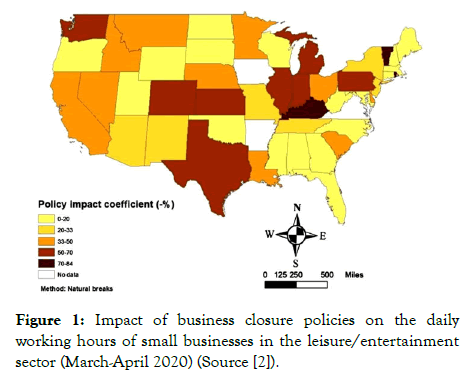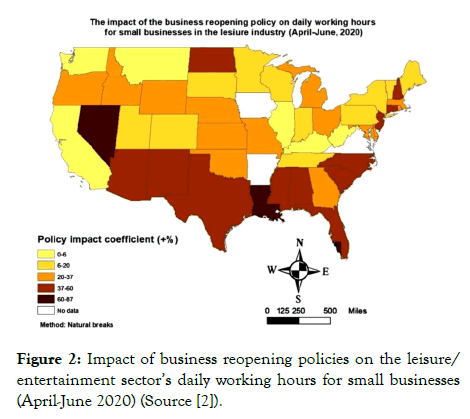Journal of Tourism & Hospitality
Open Access
ISSN: 2167-0269
ISSN: 2167-0269
Commentary - (2021)
This commentary discusses the article “Understanding the impact of Covid-19 intervention policies on the hospitality labor market” written by Arthur Huang and his collaborators. By using high-frequency data from small hospitality businesses in the United States, their time series analysis uncovers how state intervention policies affect the hospitality labor market. Specifically, the number of businesses open, number of working hours, and number of non-salaried employees are considered. From their findings, implications and additional thoughts are described.
Covid-19; Policy; Small business
Traditionally, the hospitality and tourism industry plays a significant role in the United States labor market and economy. For example, the industry provided around 30% of the labor force and 20% of the country’s GDP in 2017 [1]. However, the Covid-19 pandemic has undoubtedly devasted the industry. Given the safety precautions necessitated by the disease’s transmissible nature, tourism was forced to come to an abrupt halt around the world. In the United States alone, this cessation resulted in millions losing their jobs as companies were forced to reinvent and reorganize themselves to survive the pandemic. During 2020, the hospitality industry’s unemployment rate soared from 8.1% in March to 39.3% in April and remained higher for the rest of the year than it had at any point throughout the previous decade [2]. The unemployment spike can be attributed to the national response to the crisis, which involved individual states issuing stay-at-home orders and ordering the closure of non-essential businesses and activities. Arthur Huang and his fellow researchers examined how such intervention policies affected small businesses in the hospitality industry in their work titled, “Understanding the impact of Covid-19 intervention policies on the hospitality labor market” [3]; this commentary discusses their work.
Huang and his team examined the effects of Covid-19 intervention policies (i.e., non-essential business closure, social distancing, reduced capacity) on small businesses within the leisure/entertainment and food/drink sectors of the hospitality industry in the United States. The leisure/entertainment sector was more significantly affected than the food/drink industry by state intervention policies; this is not surprising as the intervention policies involved the closure of non-essential businesses, where leisure/entertainment was categorized. The food/drink sector was dramatically affected as well; however, restaurants were allowed to operate given the constraints of takeout only models, initially. Grocery stores, convenience stores, and drug stores remained open under strict guidance regarding capacity limitations, hour reductions, sanitation procedures, and the use of personal protective equipment by employees and consumers. The effects of business closure policies on the daily working hours of the leisure/entertainment sector is illustrated in Figure 1. The rise of Covid-19 cases reported daily was negatively related to hospitality labor market performance, but the relationship between business closure policies and daily Covid-19 cases reported indicates that the policies may have assisted in reducing the transmission of the disease.

Figure 1: Impact of business closure policies on the daily working hours of small businesses in the leisure/entertainment sector (March-April 2020) (Source [2]).
Following the closure, business reopening policies were implemented across states at different rates. The effects of business reopening policies on the daily working hours of the leisure/entertainment sector is illustrated in Figure 2. The reopening policies assisted in healing the labor market by increasing the number of small businesses open for operation and, ultimately, the number of people working.

Figure 2: Impact of business reopening policies on the leisure/ entertainment sector’s daily working hours for small businesses (April-June 2020) (Source [2]).
Each state in the United States, and each region, depends on different resources and industries to drive their economies. Similarly, state populations in the United States vary widely from 39.5 million in California down to 580,000 in Wyoming [4]. This indicates that states must undergo phased reopening procedures relative to their current situation and number of Covid-19 cases. Moreover, as the newly developed vaccines are administered, hospitality businesses should continue to regard the safety precautions and policies provided by the Centers for Disease Control and Prevention (CDC). Disregarding compliance may be counterproductive as non-compliance may result in legal ramifications and contribute to the diffusion of the disease. Managers must enforce safety standards while seeking appropriate policy and physical modifications on a caseby- case basis. Additionally, businesses should consider adopting technology to increase the flexibility and resilience of their operations. For example, digital menus, mobile ordering, mobile payment, digital hotel room keys, and contactless check-in processes are some of the technology-reliant methods the industry has increasingly adopted.
The Covid-19 pandemic shocked the hospitality and tourism industry; the industry’s various sectors all atrophied but deteriorated unequally. Hospitality’s service-oriented essence proved to be particularly vulnerable to Covid-19’s transmissibility as intervention policies were implemented to reduce travel and close non-essential businesses. The industry adapted by adopting new organizational structures, service methods, operational standards, and technologies. Unfortunately, part of the adaptation involved eliminating millions of jobs due to businesses lacking the profits necessary to employ their workers. The United States economy suffered as hospitality and tourism activities were largely deemed to be nonessential. While such activities may not be required for everyday life, the economic contributions of hospitality activities proved to be particularly essential given their absence. For the future, the industry looks to fortify itself to increase its resistance against external shocks. However, to what extent can an industry that relies so heavily on people resist a disease that exploits people as its vector?
Citation: Huang A, Baker M (2021) The Effects of COVID-19 Closure Policies on Small Hospitality Businesses. J Tourism Hospit.S1:001.
Received: 12-Jan-2021 Accepted: 26-Jan-2021 Published: 02-Feb-2021 , DOI: 10.35248/2167-0269.21.s1.001
Copyright: © 2021 Huang A, et al. This is an open-access article distributed under the terms of the Creative Commons Attribution License, which permits unrestricted use, distribution, and reproduction in any medium, provided the original author and source are credited.